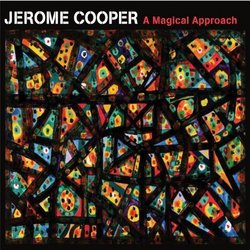| All Artists: Jerome Cooper Title: A Magical Approach Members Wishing: 1 Total Copies: 0 Label: Mutable Music Original Release Date: 1/1/2010 Re-Release Date: 7/15/2010 Genre: Jazz Style: Avant Garde & Free Jazz Number of Discs: 1 SwapaCD Credits: 1 UPCs: 801021753827, 801021753827 |
Search - Jerome Cooper :: A Magical Approach
 | Jerome Cooper A Magical Approach Genre: Jazz
Drummer/percussionist Jerome Cooper's fruitful musical legacy with the Revolutionary Ensemble and stints with saxophonist/composer Anthony Braxton, pianist Cecil Taylor, and others reads like a who's who in modern jazz. Th... more » |
Larger Image |
CD Details
Synopsis
Product Description
Drummer/percussionist Jerome Cooper's fruitful musical legacy with the Revolutionary Ensemble and stints with saxophonist/composer Anthony Braxton, pianist Cecil Taylor, and others reads like a who's who in modern jazz. This makes A Magical Approach - a new release of Jerome Cooper s multi-dimensional drumming, a very special event. The music on this CD is drawn from two live performances, recorded almost 30 years apart. Root Assumptions was recorded in 1978 while the other five tracks are from Cooper s 2007 performance at an A.A.C.M. concert. Cooper's remarkable agility and captivating musical spirit is enacted throughout these endearing works. What is multi-dimensional drumming? Imagine a drummer who plays this flute with one hand, bass drum and high-hat with his feet, and triggers drum loops, chord sequences and bass patterns with his other hand. Whether it is written or improvised, the resulting music is closer to world-funk than avant-garde jazz. Divided into many parts and facets, the drum set and secondary instruments Cooper uses and play are all aspects of the drums. In the future, there will be many changes and developments in the area of the mind so what we (humankind) think and hear, is what we shall see and hear. In order to play the drum set you must be able to manipulate four or five things at one time (i.e. bass drum, snare drum, high-hat, ride cymbals and maybe voice). So an instruments name and structure doesn t stop him from playing them like a drum. You have instruments that are structurally different from the drum, but they have the same characteristic in the approach to the drum (i.e. piano, balaphone and shoes with taps). In order to find the music of the drums, Cooper had to change my assumptions and beliefs about music in relation to the drums, which is sound in the creation of multi-rhythms. Cooper studied with Oliver Coleman and Walter Dyett in the late 1950s and early 1960s, then studied at the American Conservatory and Loop College. In 1968 he worked with Oscar Brown, Jr. and Kalaparusha Maurice McIntyre in the U.S. but moved to Europe before the end of the decade, where he played with Steve Lacy, Lou Bennett, the Art Ensemble of Chicago, Alan Silva, Frank Wright, and Noah Howard. After returning to the U.S. in 1971, he joined the Revolutionary Ensemble alongside Leroy Jenkins and Sirone, where he remained for several years and played piano, flute, and bugle in addition to drums. In the 1970s he also played with Sam Rivers, George Adams, Karl Berger, Andrew Hill, and Anthony Braxton. In the 1980s he worked again with McIntyre and with Cecil Taylor.

 Track Listings (6) - Disc #1
Track Listings (6) - Disc #1